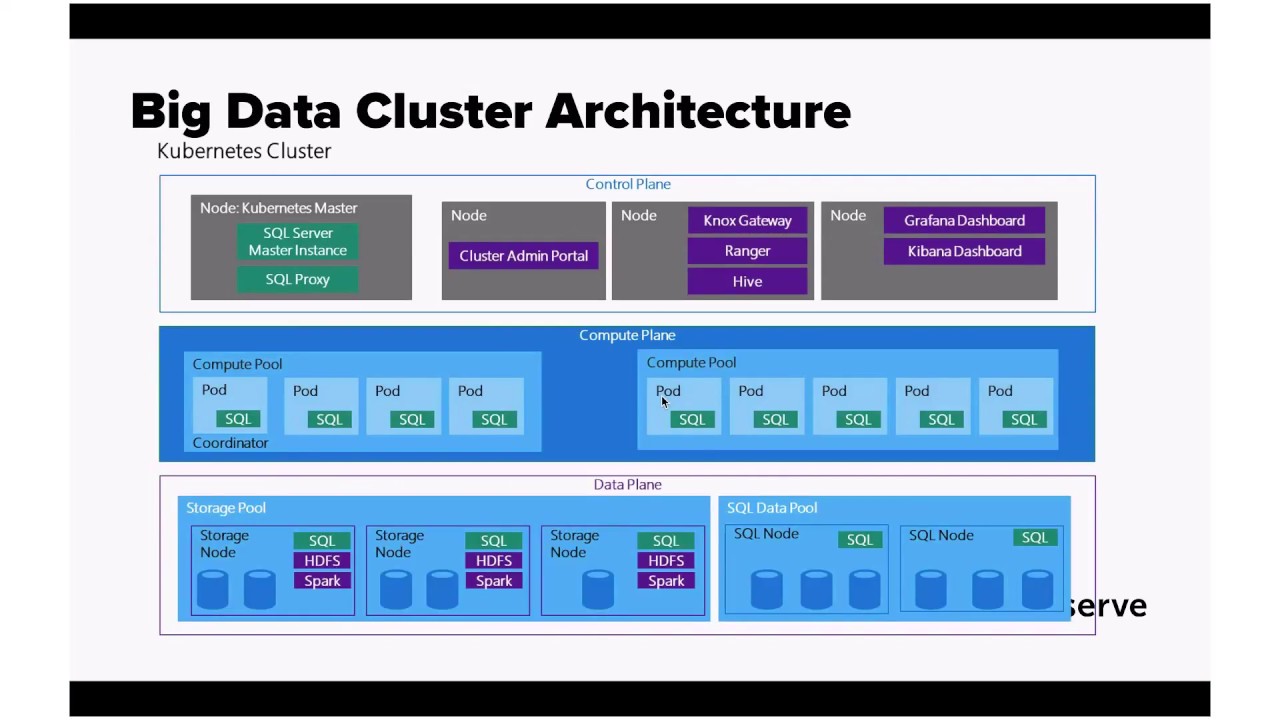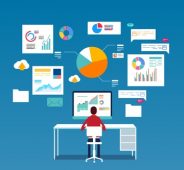Introduction
In today’s digital age, the world is generating an unprecedented amount of data every second. This massive volume of data, known as Big Data, holds valuable insights and opportunities for businesses across various industries. However, analyzing this vast amount of data requires specialized skills and expertise. This is where a Big Data Analyst comes into play.
A Big Data Analyst is an individual who possesses the knowledge and skills to collect, interpret, and derive meaningful insights from large and complex datasets. They play a crucial role in helping organizations make informed decisions, optimize business processes, and identify trends and patterns that can drive innovation and growth.
Additionally, Big Data Analysts utilize cutting-edge technologies and tools to handle and analyze data efficiently. By leveraging their analytical skills and expertise, they are able to extract valuable information from massive datasets, turning raw data into actionable insights.
In this article, we will explore the skills required, education and training options, as well as the necessary steps to become a successful Big Data Analyst. Whether you are a data enthusiast looking to embark on a new career path or a professional seeking to advance in the field of data analytics, this guide will provide you with valuable insights to kickstart and navigate your journey in the world of Big Data Analysis.
So, buckle up and get ready to dive into the exciting world of Big Data Analysis!
What is a Big Data Analyst?
A Big Data Analyst is a professional who specializes in analyzing and extracting insights from large and complex datasets to support decision-making processes. They possess a deep understanding of statistical analysis, data mining techniques, and data visualization tools to uncover patterns, trends, and correlations within the data.
The role of a Big Data Analyst goes beyond simply interpreting data. They are responsible for cleaning and preparing data for analysis, ensuring its accuracy and reliability. They also collaborate with stakeholders to identify business objectives and develop data-driven strategies to achieve them.
Big Data Analysts employ various analytical techniques, including machine learning algorithms, to process and analyze vast amounts of structured and unstructured data. They use programming languages, such as Python or R, to manipulate and analyze data efficiently. Additionally, they leverage advanced data visualization tools, like Tableau or Power BI, to present their findings in a visually engaging and easily understandable manner.
One of the essential skills of a Big Data Analyst is their ability to interpret and communicate complex data insights to stakeholders. They must possess strong written and verbal communication skills to present their findings, recommendations, and insights effectively. Their role is crucial in helping organizations make data-driven decisions, identify opportunities for growth, and solve complex business problems.
Moreover, a Big Data Analyst must stay updated with the latest trends, technologies, and techniques in the field of data analysis. As technology rapidly evolves, new tools and platforms emerge, and data sources continue to expand, it is essential for Big Data Analysts to continuously update their skills and adapt to changing demands.
In summary, a Big Data Analyst is a highly skilled professional who possesses the expertise to analyze and extract valuable insights from large and complex datasets. They play a pivotal role in helping businesses make informed decisions, optimize processes, and gain a competitive edge in today’s data-driven world.
Skills Required to Become a Big Data Analyst
Becoming a successful Big Data Analyst requires a combination of technical, analytical, and soft skills. Here are some of the essential skills needed to excel in this field:
1. Data Analysis: A strong foundation in data analysis is crucial for a Big Data Analyst. This includes understanding various data analysis techniques, statistical methods, and the ability to interpret and draw insights from data.
2. Programming: Proficiency in programming languages like Python, R, or SQL is vital for data manipulation, analysis, and building data models. These languages are commonly used in Big Data Analysis to process large datasets efficiently.
3. Data Visualization: The ability to visualize and present data effectively is an important skill for a Big Data Analyst. Tools like Tableau, Power BI, or D3.js can be used to create visually appealing and informative data visualizations.
4. Machine Learning: Knowledge of machine learning algorithms and techniques is becoming increasingly important in the field of Big Data Analysis. Understanding how to apply these algorithms to solve complex business problems is highly valuable.
5. Problem-Solving: Big Data Analysts often deal with complex datasets and challenges. The ability to think critically, analyze problems, and devise creative solutions is crucial to succeed in this role.
6. Communication: Strong communication skills are necessary to effectively convey complex data insights to stakeholders. Big Data Analysts should be able to explain technical concepts in a clear and concise manner to non-technical audiences.
7. Domain Knowledge: Having domain knowledge in the industry you are working in can give you a competitive advantage. Understanding the specific requirements, challenges, and dynamics of the industry can help you provide more relevant and valuable insights.
8. Intellectual Curiosity: Being curious and having a passion for learning is crucial in the field of Big Data Analysis. Staying updated with the latest tools, technologies, and trends in data analysis is essential to remain competitive.
9. Attention to Detail: Big Data Analysts are responsible for handling large and complex datasets, where even the smallest errors can have significant impacts. Having a keen eye for detail is important to ensure accuracy in data analysis.
10. Teamwork: Collaboration and teamwork skills are essential for Big Data Analysts. They often work in multidisciplinary teams, where effective communication, cooperation, and coordination are crucial to achieve common goals.
Developing these skills, either through formal education or on-the-job training, can pave the way to a successful career as a Big Data Analyst.
Education and Training for Big Data Analysis
To become a Big Data Analyst, there are several educational paths and training options available to acquire the necessary knowledge and skills. Here are some of the common routes to consider:
1. Bachelor’s Degree in Data Science or a Related Field: Pursuing a bachelor’s degree in Data Science, Statistics, Computer Science, or a related field can provide a solid foundation in data analysis and programming. These programs typically cover courses in mathematics, statistics, data mining, programming, and data visualization.
2. Master’s Degree in Data Analytics or Big Data: A master’s degree in Data Analytics or Big Data can provide a more in-depth understanding of advanced data analysis techniques, machine learning, and big data technologies. These programs often include coursework in data mining, predictive analytics, data warehousing, and cloud computing.
3. Online Courses and MOOCs: Online platforms like Coursera, edX, and Udemy offer a wide range of courses and Massive Open Online Courses (MOOCs) specifically focused on Big Data Analysis. These courses cover various topics such as data visualization, machine learning, and big data technologies, allowing you to learn at your own pace.
4. Professional Certifications: Obtaining certifications in relevant areas, such as data analysis, machine learning, or specific big data technologies, can demonstrate your expertise to potential employers. Certifications like the Certified Analytics Professional (CAP) or the Cloudera Certified Data Analyst (CCDA) can validate your skills in data analysis and big data technologies.
5. Industry Seminars and Workshops: Attending industry seminars, conferences, and workshops can provide valuable insights into the latest trends, tools, and techniques in Big Data Analysis. These events often offer networking opportunities and the chance to learn from industry experts and thought leaders.
6. Hands-On Projects and Internships: Gaining practical experience through hands-on projects and internships can significantly enhance your skills as a Big Data Analyst. Working on real data sets and applying data analysis techniques in a real-world context will help you develop a deep understanding of data analysis methodologies.
7. Continuous Learning and Self-Study: The field of Big Data Analysis is constantly evolving. It’s essential to stay updated with the latest industry developments, tools, and technologies. Engage in self-study, explore online resources, and join communities and forums where you can learn from and collaborate with other data professionals.
While formal education can provide a solid foundation, practical experience, continuous learning, and staying updated with the latest industry trends are equally important for a successful career in Big Data Analysis.
Tools and Technologies Used in Big Data Analysis
Big Data Analysis involves working with massive volumes of data, requiring powerful tools and technologies to handle, process, and analyze the information effectively. Here are some of the commonly used tools and technologies in the field of Big Data Analysis:
1. Hadoop: Hadoop is an open-source framework that allows distributed processing and storage of large data sets across clusters of computers. It provides a reliable and scalable platform for handling big data and enables parallel processing capabilities.
2. Apache Spark: Apache Spark is a fast and powerful data processing engine that provides in-memory processing capabilities. It can handle both batch and real-time data processing and offers a wide range of libraries for data analysis, machine learning, and graph processing.
3. SQL and NoSQL Databases: Structured Query Language (SQL) databases like MySQL and PostgreSQL are commonly used for storing and accessing structured data. NoSQL databases like MongoDB and Cassandra are used for handling unstructured and semi-structured data or when scalability and flexibility are paramount.
4. Apache Kafka: Apache Kafka is a distributed streaming platform used for building real-time data pipelines and streaming applications. It is highly scalable, fault-tolerant, and can handle high-throughput data streams, making it suitable for handling real-time data analysis.
5. Python and R: Python and R are popular programming languages for data analysis and machine learning. They offer extensive libraries and frameworks, such as Pandas, NumPy, and Scikit-learn in Python, and ggplot2 and caret in R, enabling efficient data manipulation, statistical analysis, and predictive modeling.
6. Data Visualization Tools: Tools like Tableau, Power BI, and D3.js are commonly used for visualizing and presenting data. These tools provide interactive and visually appealing dashboards, charts, and graphs, allowing for easier interpretation and communication of data insights.
7. Machine Learning Libraries: Libraries like TensorFlow, PyTorch, and scikit-learn provide machine learning capabilities for analyzing and modeling big data. These libraries offer pre-built algorithms, neural network architectures, and tools for training, testing, and evaluation of machine learning models.
8. Cloud Computing Platforms: Cloud computing platforms like Amazon Web Services (AWS), Google Cloud Platform (GCP), and Microsoft Azure offer scalable and cost-effective solutions for storing, processing, and analyzing big data. These platforms provide a wide range of services, including data storage, data processing, and analytics tools.
9. Data Integration and ETL Tools: Data integration and Extract, Transform, Load (ETL) tools like Informatica, Talend, and Apache NiFi help with integrating and transforming data from various sources into a unified format suitable for analysis. These tools assist in data cleansing, data quality assurance, and data integration tasks.
10. Open Source Data Analysis Tools: Open-source tools like Jupyter Notebook, Apache Zeppelin, and KNIME provide interactive environments for data analysis and visualization. They allow for code execution, documentation, and collaboration, making them popular among data analysts and scientists.
These are just a few examples of the tools and technologies used in Big Data Analysis. The field is constantly evolving, and new tools and technologies emerge regularly, offering more advanced and efficient ways to analyze and derive insights from large datasets.
Steps to Become a Big Data Analyst
Becoming a Big Data Analyst requires a combination of education, technical skills, and practical experience. Here are the steps you can follow to embark on a successful career as a Big Data Analyst:
Step 1: Develop Strong Analytical Skills: Begin by honing your analytical skills. Cultivate a strong ability to think critically, solve problems, and analyze complex data sets. Take courses or engage in activities that sharpen your analytical thinking abilities.
Step 2: Learn Programming Languages for Data Analysis: Familiarize yourself with programming languages commonly used in data analysis, such as Python, R, or SQL. Learn how to manipulate data, perform statistical analysis, and create data models using these languages.
Step 3: Gain Knowledge of Statistics and Mathematics: Understand the fundamentals of statistics and mathematics as they form the basis of data analysis. Learn about probability, hypothesis testing, regression analysis, and other statistical concepts relevant to data analysis.
Step 4: Master Big Data Technologies and Tools: Gain expertise in tools and technologies specifically designed for Big Data Analysis. Learn how to work with frameworks like Hadoop, Apache Spark, and Apache Kafka, which handle the processing and analysis of large datasets.
Step 5: Obtain Relevant Certifications: Consider obtaining certifications that validate your skills in Big Data Analysis. Certifications like the Certified Analytics Professional (CAP) or Microsoft Certified: Azure Data Scientist Associate can demonstrate your proficiency to potential employers.
Step 6: Build a Strong Portfolio: Create a portfolio that showcases your data analysis projects and accomplishments. Include real-world examples of data analysis work you have done, showcasing your ability to handle and draw insights from large datasets.
Step 7: Keep Learning and Stay Updated: The field of Big Data Analysis is constantly evolving, with new tools, technologies, and techniques emerging regularly. Stay updated with the latest trends, attend conferences, participate in online courses, and engage in continuous learning to stay ahead in the field.
By following these steps, you can develop the skills and knowledge necessary to embark on a successful career as a Big Data Analyst. Remember to always seek opportunities to gain practical experience and apply your skills in real-world scenarios to further enhance your capabilities.
Step 1: Develop Strong Analytical Skills
An essential first step towards becoming a Big Data Analyst is to develop strong analytical skills. Analytical thinking is the ability to break down complex problems, assess data and information, and derive meaningful insights. Here are some steps to help you develop and strengthen your analytical skills:
1. Curiosity and Inquisitiveness: Foster a curious mindset and a desire to dig deeper into data and information. Ask questions, seek understanding, and constantly strive to uncover the underlying patterns and connections.
2. Critical Thinking: Enhance your critical thinking skills by evaluating information objectively, considering different perspectives, and making logical connections. This skill will help you analyze problems and develop effective solutions.
3. Problem-solving: Challenges in Big Data Analysis often involve solving complex problems. Develop problem-solving skills by breaking down problems into smaller parts, identifying possible solutions, and evaluating their feasibility and effectiveness.
4. Data Interpretation: Learn how to effectively analyze and interpret data. Familiarize yourself with statistical techniques and methods used in data analysis, such as data segmentation, regression analysis, or hypothesis testing.
5. Critical Reading and Synthesis: Improve your ability to analyze and synthesize information from various sources. Practice critical reading to extract relevant information, identify key insights, and synthesize them into a cohesive understanding.
6. Cognitive Flexibility: Flexibility in thinking is crucial in Big Data Analysis. Develop the ability to approach problems from different angles, adapt to new information, and consider alternative solutions.
7. Attention to Detail: Pay close attention to details, as they can affect the accuracy and reliability of your analysis. Develop a meticulous approach to data analysis to avoid errors and ensure the quality of your findings.
8. Data-driven Decision Making: Embrace a data-driven approach to decision-making. Practice using data as the foundation for decision-making, considering both quantitative and qualitative factors to make informed choices.
9. Practice with Real-world Data: Gain practical experience by working with real-world datasets. Explore open-source datasets or take part in data analysis projects to apply your analytical skills and gain hands-on experience.
10. Continuous Learning: Analytical skills can be further developed through continuous learning. Engage in online courses, workshops, or read books related to data analysis, statistics, and critical thinking to expand your knowledge and stay up-to-date with industry best practices.
Developing strong analytical skills will provide a solid foundation for your journey as a Big Data Analyst. Cultivate these skills by actively seeking opportunities to apply them in different contexts and consistently challenging yourself to think critically and analytically.
Step 2: Learn Programming Languages for Data Analysis
In the world of Big Data Analysis, programming languages play a crucial role in manipulating, analyzing, and visualizing data. Learning programming languages specifically tailored for data analysis will empower you to work efficiently with large and complex datasets. Here are the key steps to master programming languages for data analysis:
1. Choose the Right Language: Select a programming language that is widely used in the field of data analysis. Python and R are two popular languages known for their extensive libraries, tools, and frameworks designed for data analysis tasks.
2. Learn the Basics: Begin by understanding the fundamental concepts and syntax of the chosen programming language. Familiarize yourself with variables, data types, functions, loops, conditionals, and other essential programming concepts.
3. Data Manipulation: Master data manipulation techniques within the programming language. Learn how to load, clean, and transform raw data into a format suitable for analysis. Gain proficiency in handling data frames, arrays, and other data structures specific to the language.
4. Statistical Analysis: Explore the statistical analysis capabilities of the programming language. Understand how to perform common statistical operations, such as calculating mean, median, variance, and correlations, and apply them to analyze datasets.
5. Data Visualization: Acquire skills in creating informative and visually appealing data visualizations using the programming language. Learn how to generate charts, graphs, and other visual representations that effectively communicate insights to stakeholders.
6. Advanced Libraries and Frameworks: Dive deeper into the language’s data analysis capabilities by exploring advanced libraries and frameworks. For Python, libraries like Pandas and NumPy provide powerful data manipulation and analysis tools. R offers packages like ggplot2 and dplyr for data visualization and manipulation.
7. Work on Projects: Apply your programming skills to real-world projects. Undertake data analysis projects that require you to apply the programming language to extract insights from actual datasets. This hands-on experience will solidify your comprehension and enhance your problem-solving abilities.
8. Practice and Collaborate: Engage in coding exercises and practice regularly to refine your programming skills. Participate in online coding communities and collaborate with other data enthusiasts or professionals to improve your expertise and learn from different perspectives.
9. Stay Updated: Programming languages and their associated libraries evolve continuously. Keep abreast of updates, new features, and best practices by following relevant blogs, forums, and online communities. Continuous learning ensures you are leveraging the latest tools and techniques to enhance your data analysis skills.
10. Expand your Toolkit: While mastering one programming language is essential, consider expanding your toolkit as different languages may excel in specific areas. For example, Python is popular for its versatility, while R offers rich statistical analysis capabilities. Being proficient in multiple languages broadens your opportunities and flexibility as a Big Data Analyst.
By following these steps and dedicating sufficient time and effort, you can develop proficiency in programming languages for data analysis and unlock the power to handle and analyze large datasets effectively.
Step 3: Gain Knowledge of Statistics and Mathematics
A solid understanding of statistics and mathematics is essential for a Big Data Analyst. Statistical analysis provides the foundation for examining and interpreting data, while mathematics underlies many analytical techniques used in data analysis. To gain knowledge of statistics and mathematics relevant to data analysis, follow these steps:
1. Fundamentals of Statistics: Start by grasping the fundamental concepts of statistics, including measures of central tendency (mean, median, mode), variability (standard deviation, variance), and probability theory. Learn about statistical distributions and hypothesis testing.
2. Statistical Analysis Techniques: Dive deeper into statistical analysis techniques such as regression analysis, correlation analysis, and time series analysis. Understand how to apply these techniques to analyze relationships, trends, and patterns in data.
3. Experimental Design: Gain knowledge of experimental design principles to build robust experiments and studies. Learn about sampling techniques, control groups, and randomization methods to ensure statistical validity in data analysis.
4. Mathematical Foundations: Develop a strong foundation in mathematics, including algebra, calculus, and linear algebra. These mathematical concepts are essential for understanding and implementing advanced data analysis algorithms and models.
5. Multivariate Statistics: Explore multivariate statistical techniques such as factor analysis, cluster analysis, and principal component analysis. These techniques enable the analysis of relationships and patterns across multiple variables.
6. Probability and Bayesian Analysis: Acquire knowledge of probability theory and Bayesian analysis to understand uncertainty and make probabilistic inferences. Learn about Bayes’ theorem and its practical applications in data analysis.
7. Statistical Software: Familiarize yourself with statistical software packages commonly used in data analysis, such as SPSS, SAS, or STATA. These tools provide intuitive interfaces and capabilities to perform complex statistical analyses.
8. Practical Application: Apply statistical concepts to real-world data analysis projects. Work on practical exercises and projects that challenge your understanding of statistical techniques and their application to datasets.
9. Continuous Learning: Statistics and mathematics are vast fields, and they continue to evolve. Keep yourself updated with new developments, techniques, and best practices through books, online courses, and professional networks.
10. Collaboration and Discussion: Engage in discussions with other data analysts, statisticians, and mathematicians. Collaborate on projects, attend workshops, and join online communities to learn from experts and gain insights into different approaches to data analysis.
By following these steps and investing time and effort into expanding your statistical and mathematical knowledge, you will develop the necessary foundations to effectively analyze and interpret data as a Big Data Analyst.
Step 4: Master Big Data Technologies and Tools
In the field of Big Data Analysis, mastering the relevant technologies and tools is crucial for efficiently handling and processing large and complex datasets. To become a proficient Big Data Analyst, follow these steps to master the key technologies and tools:
1. Hadoop: Hadoop is a widely used framework for distributed storage and processing of large datasets. Familiarize yourself with the Hadoop ecosystem, including the Hadoop Distributed File System (HDFS) and MapReduce, to understand how to handle and analyze big data efficiently.
2. Apache Spark: Apache Spark is a powerful data processing and analytics engine that offers faster data processing and real-time streaming capabilities. Learn how to leverage Spark’s functionalities to handle big data analysis tasks effectively.
3. SQL and NoSQL Databases: Gain expertise in working with both SQL and NoSQL databases. SQL databases like MySQL and PostgreSQL are commonly used for structured data, while NoSQL databases like MongoDB and Cassandra are used for handling unstructured and semi-structured data.
4. Data Warehousing: Familiarize yourself with concepts and technologies related to data warehousing, such as Extract, Transform, Load (ETL) processes, data modelling, and data integration. Understand how to design and build efficient data warehouses for large-scale data analysis.
5. Data Streaming: Learn about data streaming technologies like Apache Kafka or Amazon Kinesis. These tools enable the processing and analysis of real-time streaming data, which is crucial in various industries where timely insights are required.
6. Programming Languages for Big Data: Enhance your proficiency in programming languages specifically used for Big Data Analysis, such as Python and Scala. Learn how to manipulate, analyze, and visualize large datasets using these languages and their associated frameworks and libraries.
7. Data Visualization Tools: Master data visualization tools and libraries, such as Tableau, Power BI, or matplotlib in Python. Learn how to create visually appealing and informative visualizations to present data insights effectively to stakeholders.
8. Cloud Platforms: Gain hands-on experience with cloud platforms like Amazon Web Services (AWS), Google Cloud Platform (GCP), or Microsoft Azure. Understand how to leverage the cloud for storing and processing big data, including using services like AWS S3, GCP BigQuery, or Azure HDInsight.
9. Machine Learning Algorithms and Libraries: Gain knowledge of machine learning algorithms and libraries and understand how to apply them to big data analysis. Explore frameworks like scikit-learn, TensorFlow, or PyTorch to develop predictive models and uncover insights from data.
10. Continuous Learning and Adaptation: Keep yourself updated with the latest advancements in big data technologies and tools. Engage in continuous learning through online courses, industry events, and active participation in the big data community.
By mastering these big data technologies and tools, you will be equipped with the skills and knowledge necessary to handle and analyze large datasets efficiently as a Big Data Analyst.
Step 5: Obtain Relevant Certifications
Obtaining relevant certifications can significantly enhance your credibility and demonstrate your expertise as a Big Data Analyst. Certifications provide validation of your skills and knowledge in specific areas of big data analysis. Here are the essential steps to obtain relevant certifications:
1. Identify Certification Programs: Research and identify reputable certification programs that align with your career goals and the specific skills you want to showcase. Look for certifications offered by recognized organizations or industry leaders in big data analysis.
2. Choose Specializations: Decide on the specific area or specialization within big data analysis that you want to pursue certification in. Some common specializations include data analysis, data engineering, machine learning, or big data technologies like Hadoop or Spark.
3. Prerequisites and Eligibility: Check the prerequisites and eligibility criteria for each certification program. Ensure that you meet the educational requirements, work experience, or any other prerequisites before proceeding with the certification process.
4. Prepare and Study: Allocate dedicated time for exam preparation. Study the certification exam syllabus, recommended resources, and sample questions to understand the scope and depth of knowledge required. Review related theories, concepts, and practical applications to solidify your understanding.
5. Training Programs: Enroll in training programs specifically designed to prepare you for the certification exam. Many certification programs offer official training courses or recommend third-party training providers that can help you cover the necessary knowledge and skills.
6. Practice Exams: Take advantage of practice exams or sample questions provided by the certification program. These practice exams help you familiarize yourself with the exam format, assess your readiness, and identify areas that require additional focus or study.
7. Register for the Exam: Once you feel prepared, register for the certification exam. Check the availability, schedule, and examination format to plan accordingly. Some exams may be available online, while others may be conducted at designated testing centers.
8. Exam Day: On the day of the exam, ensure that you are well-rested and prepared. Follow the exam guidelines and instructions provided by the certification program. Stay focused, manage your time wisely, and carefully read and analyze each question before providing your answer.
9. Obtain Certification: After completing the exam, patiently wait for the results to be announced. If you meet the passing criteria, you will receive your certification. Celebrate your achievement and update your professional profiles to showcase your new certification.
10. Continuous Learning: Certifications are not the end of your learning journey. Stay updated with the evolving field of big data analysis by engaging in continuous learning. Attend webinars, workshops, conferences, and seek opportunities for professional development along with maintaining your certification.
Obtaining relevant certifications demonstrates your dedication to professional growth and enhances your credibility as a Big Data Analyst. They can help distinguish you from other candidates and open doors to new career opportunities in the ever-evolving world of big data analysis.
Step 6: Build a Strong Portfolio
Building a strong portfolio is an important step in establishing yourself as a competent Big Data Analyst. A portfolio showcases your skills, expertise, and real-world experience in data analysis. Here are the key steps to build a persuasive portfolio:
1. Select Relevant Projects: Identify and select data analysis projects that demonstrate your abilities in handling large and complex datasets. Choose projects that highlight different aspects of your skills, such as data cleaning, exploratory analysis, predictive modeling, or data visualization.
2. Showcase Different Techniques: Include projects that showcase a variety of data analysis techniques you have mastered. Feature projects that involve statistical analysis, machine learning models, data visualization, or any specialized techniques you have expertise in.
3. Provide Context and Background: For each project, provide a brief overview that describes the project’s objectives, data sources, and any challenges you faced. Help the reader understand the context, significance, and scope of your work.
4. Describe Methodologies and Tools Used: Clearly explain the methodologies and techniques you employed in each project. Specify the programming languages, software, libraries, and frameworks you used to extract, clean, analyze, and visualize the data.
5. Highlight Results and Insights: Showcase the outcomes of your data analysis projects by presenting the results, insights, and actionable recommendations derived from your analysis. Demonstrate how your analysis contributed to solving real-world problems or driving business decision-making.
6. Visualize Data Effectively: Apply effective data visualization techniques to present your findings. Utilize charts, graphs, infographics, or interactive visualizations to communicate complex information in a clear and compelling manner.
7. Include Code Samples: Provide code samples or snippets from your projects to demonstrate your programming skills and approach. Showcase your ability to manipulate data, perform statistical analysis, and create visualizations using relevant programming languages.
8. Present Additional Contributions: Highlight any additional contributions you made to the data analysis field, such as blog posts, articles, or presentations. This demonstrates your commitment to sharing knowledge and contributing to the industry.
9. Seek Feedback and Refine: Share your portfolio with mentors, peers, or professionals in the field for feedback. Incorporate their suggestions to improve the clarity, organization, and presentation of your portfolio.
10. Regularly Update and Expand: Continuously update and expand your portfolio as you complete new projects and gain more experience. Include a variety of projects that demonstrate your evolving skills and show that you can tackle different data analysis tasks.
Building a strong portfolio is an ongoing process. Regularly update and enhance your portfolio to reflect your growth as a Big Data Analyst. A robust portfolio will attract the attention of potential employers and demonstrate your expertise in the field of data analysis.
Step 7: Keep Learning and Stay Updated
In the fast-paced field of Big Data Analysis, continuous learning and staying updated with the latest trends, tools, and techniques are essential to maintain a competitive edge. Here are the key steps to keep learning and stay updated as a Big Data Analyst:
1. Follow Industry Publications and Blogs: Subscribe to reputable industry publications, blogs, and websites that focus on big data, data analysis, and related fields. Stay informed about new research, emerging technologies, and industry trends.
2. Join Professional Networks and Communities: Engage with other data professionals by joining professional networks, forums, and online communities. Participate in relevant discussions, share experiences, and learn from others in the field.
3. Attend Conferences and Workshops: Attend conferences, seminars, and workshops related to big data analysis. These events provide opportunities to learn from industry experts, network with peers, and gain insights into cutting-edge technologies and best practices.
4. Take Online Courses and MOOCs: Enroll in online courses and Massive Open Online Courses (MOOCs) that cover topics in big data analysis. Platforms like Coursera, edX, and Udemy offer a wide variety of courses taught by experts in the field.
5. Pursue Advanced Degrees or Certifications: Consider pursuing advanced degrees, such as a master’s degree or a Ph.D., in data science, data analytics, or a related field. Additionally, explore specialized certifications that focus on specific aspects of big data analysis to enhance your knowledge and credentials.
6. Experiment with New Technologies and Tools: Allocate time for hands-on experimentation with new technologies and tools in the field of big data analysis. Stay updated with the latest big data platforms, programming languages, libraries, and frameworks to continuously expand your skill set.
7. Engage in Side Projects and Data Challenges: Challenge yourself by working on side projects or participating in data analysis competitions and challenges. These activities provide a platform to apply your skills, explore new techniques, and learn from real-world scenarios.
8. Collaborate and Share Knowledge: Collaborate with other data professionals, attend data meetups, or join data science groups to exchange ideas, share knowledge, and engage in collaborative learning. Teaching and sharing your knowledge also deepens your understanding and solidifies your expertise.
9. Read Research Papers and Whitepapers: Stay abreast of current research and cutting-edge advancements in big data analysis by regularly reading research papers, whitepapers, and publications from academic and industry experts. This helps you stay ahead of the curve and potentially apply innovative techniques in your work.
10. Embrace Lifelong Learning: Cultivate a mindset of lifelong learning. Embrace the ever-evolving nature of big data analysis and commit to continuous personal and professional growth. Stay curious, seek out new learning opportunities, and proactively update your knowledge and skills.
By dedicating time to learning and staying updated, you will not only remain relevant in the field of big data analysis but also position yourself as a highly skilled and sought-after professional with a deep understanding of emerging trends and best practices.
Job Opportunities for Big Data Analysts
The demand for skilled Big Data Analysts continues to rise as organizations across industries recognize the value of data-driven decision-making. Big Data Analysts play a crucial role in helping businesses harness the power of data to drive innovation and gain a competitive edge. Here are some of the job opportunities available for Big Data Analysts:
Data Analyst: Data Analysts focus on analyzing and interpreting data to help organizations make informed decisions. They extract insights, perform statistical analysis, and present their findings in clear and concise reports, enabling data-driven decision-making across various departments within an organization.
Business Intelligence Analyst: Business Intelligence Analysts collect, analyze, and interpret data to identify trends, patterns, and opportunities for business growth. They play a critical role in turning raw data into actionable insights for strategic planning, operational improvements, and revenue optimization.
Big Data Engineer: Big Data Engineers develop and maintain the infrastructure required to handle and process large and complex datasets. They design and implement data pipelines, optimize data storage and retrieval systems, and ensure scalability and reliability of big data platforms like Hadoop or Spark.
Data Scientist: Data Scientists utilize statistical analysis, machine learning techniques, and programming to derive insights and build predictive models from large datasets. They work on complex business problems, design experiments, develop algorithms, and contribute to the development of data-driven products and services.
Data Visualization Specialist: Data Visualization Specialists focus on transforming complex data into visually engaging and informative visualizations. They utilize tools like Tableau, Power BI, or D3.js to create dynamic and interactive dashboards, charts, and graphs that help stakeholders understand and interpret data more effectively.
Risk Analyst: Risk Analysts use data analysis to identify, assess, and predict risks in various industries such as finance, insurance, or cybersecurity. They develop models, perform risk assessments, and provide recommendations to mitigate risks and improve decision-making processes.
Market Research Analyst: Market Research Analysts utilize data analysis techniques to collect, analyze, and interpret market data. They identify market trends, consumer behavior patterns, and competitive insights, helping businesses make strategic decisions and gain a competitive advantage.
Healthcare Data Analyst: Healthcare Data Analysts work within the healthcare industry to analyze and interpret patient data, clinical outcomes, and healthcare trends. They provide insights that aid in improving patient care, optimizing healthcare delivery, and supporting evidence-based decision-making.
Social Media Analyst: Social Media Analysts analyze social media data to derive insights about consumer behavior, sentiment analysis, and campaign performance. They use data analysis techniques to monitor social media platforms, track brand reputation, and provide recommendations for social media strategies and marketing campaigns.
Consultant: Big Data Analysts can work as consultants, either independently or within consulting firms. They provide expertise and guidance to organizations on leveraging data to solve complex business challenges, improve operations, and drive innovation.
These are just a few examples of the diverse job opportunities available for Big Data Analysts. With the continued growth of big data, organizations of all sizes and across sectors are increasingly relying on skilled professionals to harness the power of data for strategic decision-making and competitive advantage.
Conclusion
Becoming a Big Data Analyst requires a combination of technical skills, analytical abilities, and continuous learning. The field of Big Data Analysis offers a wealth of opportunities for professionals who can effectively collect, analyze, and interpret large and complex datasets to drive meaningful insights and informed decision-making.
In this guide, we have explored the essential steps to becoming a successful Big Data Analyst. These steps include developing strong analytical skills, learning programming languages for data analysis, gaining knowledge of statistics and mathematics, mastering big data technologies and tools, obtaining relevant certifications, building a strong portfolio, and staying updated with the latest industry trends.
Remember that the journey to becoming a proficient Big Data Analyst is not limited to these steps; it is an ongoing process of continuous learning and adaptation. Embrace opportunities to expand your knowledge, collaborate with peers, and explore new technologies and methodologies.
As the demand for data-driven insights grows across industries, being a skilled Big Data Analyst can lead to a rewarding and dynamic career. By investing in your skills, staying informed, and consistently delivering impactful analysis, you can make a significant impact on organizations and contribute to their success in the data-driven world.
So, take the first step, embark on your learning journey, and unlock the exciting opportunities that await you as a Big Data Analyst!

























